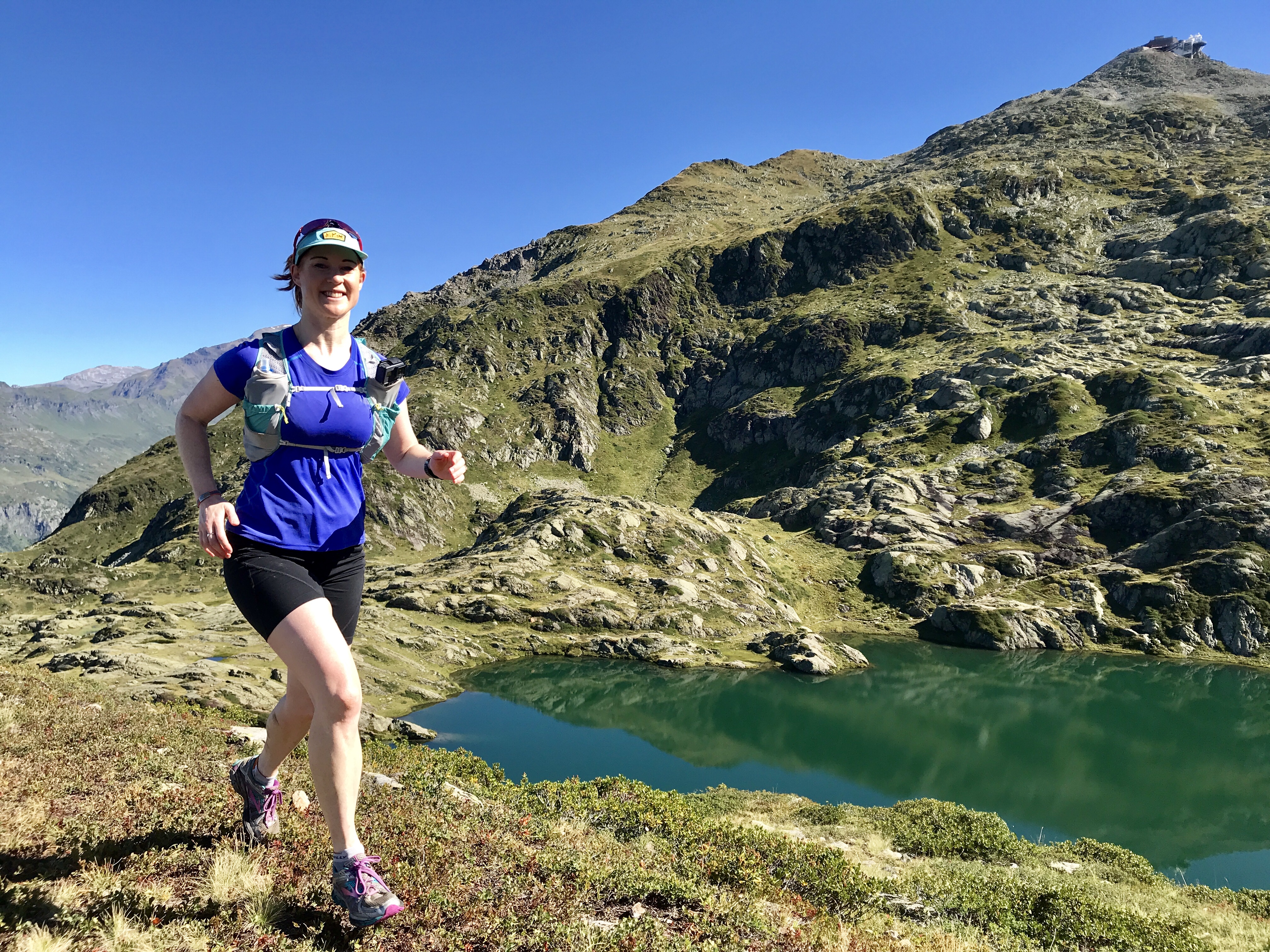The best winter running shoes: for cold, damp roads and muddy trails
The best winter running shoes will look after your feet regardless of how challenging the conditions become

The best winter running shoes let you turn what can be the most challenging time of year into the most fun. With the right footwear and the right winter garb, there’s no reason you can’t hit wet trails, muddy tracks and frozen mountainside with joyful abandon.
Our selection of the best winter running shoes features sturdy pairs with talon-like traction for soggy terrain. Many of the pairs featured here have waterproof versions, though there are pros and cons to this, which we discuss in the guide at the bottom of the page.
As with the best trail running shoes and the most comfortable trail running shoes, the best winter runners come in a variety of styles. There are maximalist pairs that give great cushioning on tarmac, shoes featuring the innovative BOA lacing system for a precise, dialed in fit and even a pair from La Sportiva that comes with an integrated gaiter and spike compatible lugs for icy terrain.
Whatever your preference there’s a pair of the best winter running shoes for you here. For pairs specifically designed for muddy trails and fell running, see our guide to the best mud running shoes.
The best winter trail running shoes for gripping mud

Specifications
Reasons to buy
Reasons to avoid
Salomon were one of the first mainstream brands to make a really grippy shoe with great traction on wet, muddy ground. First sold in 2006, the Speedcross has become an iconic shoe. Now on version 6, this latest Speedcross has some exciting improvements that make it 50g lighter per pair and take it 3mm closer to the ground. The Speedcross 6 also has a new Y-shaped tread pattern that’s better at shedding mud than the chevron-shaped grips on the Speedcross 5.
The 6 retains the comfy EnergyCell+ cushioning, foot protection, support and secure heel cup from the 5s which are all welcome features. It also sports the same QuickLacing system, whereby you simply pull the laces tight with a high-strength drawcord.
Surprisingly, the Speedcross 6 is the same price as the Speedcross 5 – usually when there’s an upgrade there’s a corresponding price hike, so although these are not budget running shoes, they’re still excellent value.
Salomon shoes are often very narrow fitting, which some people find uncomfortable, so it’s very nice to see there’s a wide-toe box version available. There’s also a Gore-Tex option should you be after a waterproof shoe this winter (see the advice below before making a decision on this).
See our full review of the Salomon Speedcross 6.
The best cushioned winter running shoes
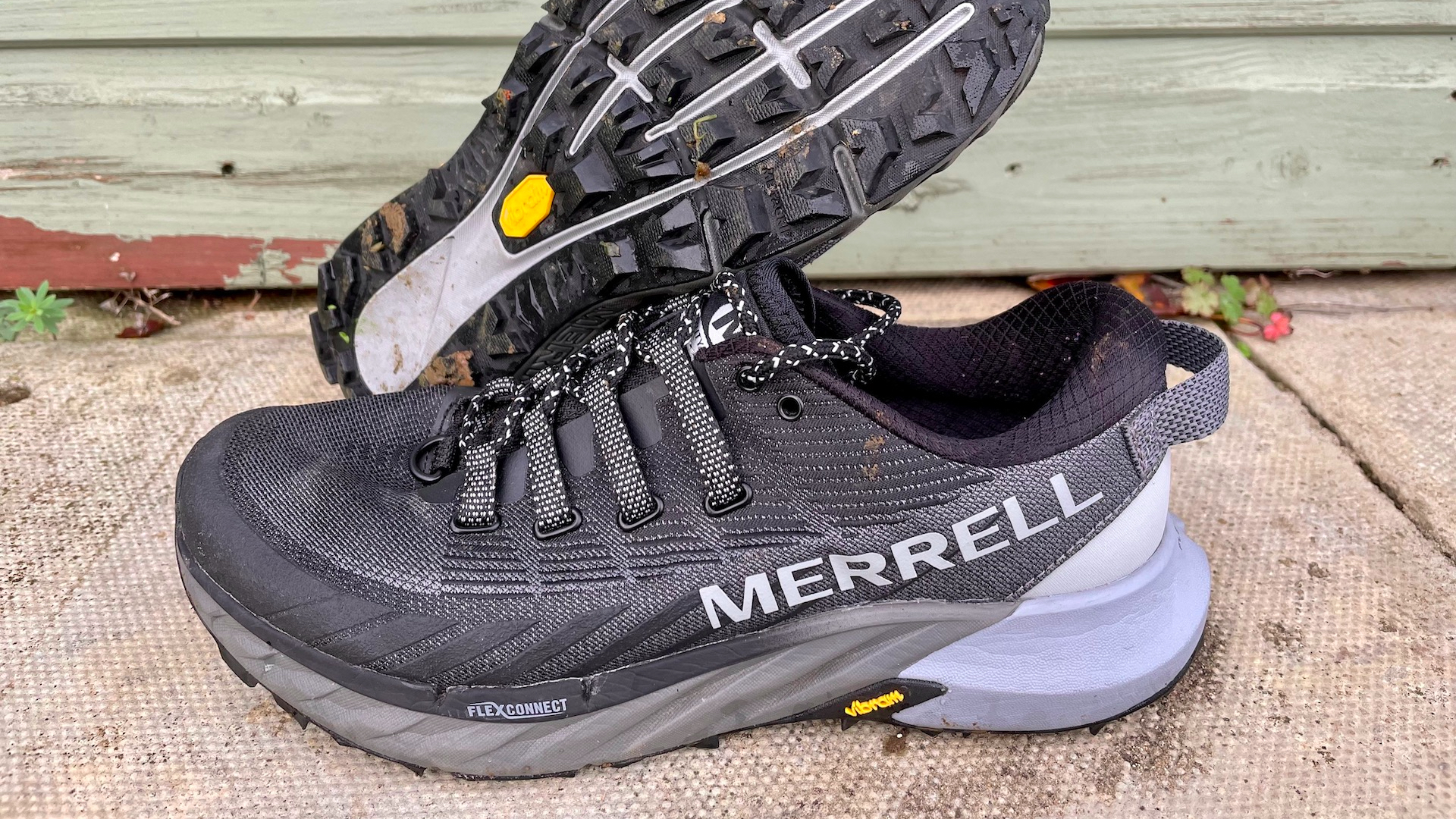
Specifications
Reasons to buy
Reasons to avoid
The Merrell Agility Peak 4s are slightly on the heavy side, at 555g / 19.8oz for a pair of UK size 6.5s, but they do come up a definite half-size bigger, so that explains this. Despite the large size, the fit feels comfy with the laces pulled well in, and the toe box is quite roomy too.
The drop is 6mm which is a good transition down from the usual 8mm and 4mm drop options common in trail-running shoes, and useful if you’re looking to transition gradually down to the lower drop shoes.
The Agility Peaks deliver a good energy return, thanks to the FloatPro Foam midsole cushioning. Your feet are protected with a rock plate, and the ride is padded and bouncy but with a good level of feel for the ground underfoot. The grip is Vibram Megagrip with 4mm lugs, which is great for traction and durability on wet and dry roads and trails.
There’s a D-ring for debris gaiters on the front lace, which is handy, but other than that this is a very straightforward, robust road and trail running shoe that will suit a great many people trotting on all sorts of terrain – including both roads and trails – this winter.
Read our full review of the Merrell Agility Peak 4.
The best lightweight winter running shoes
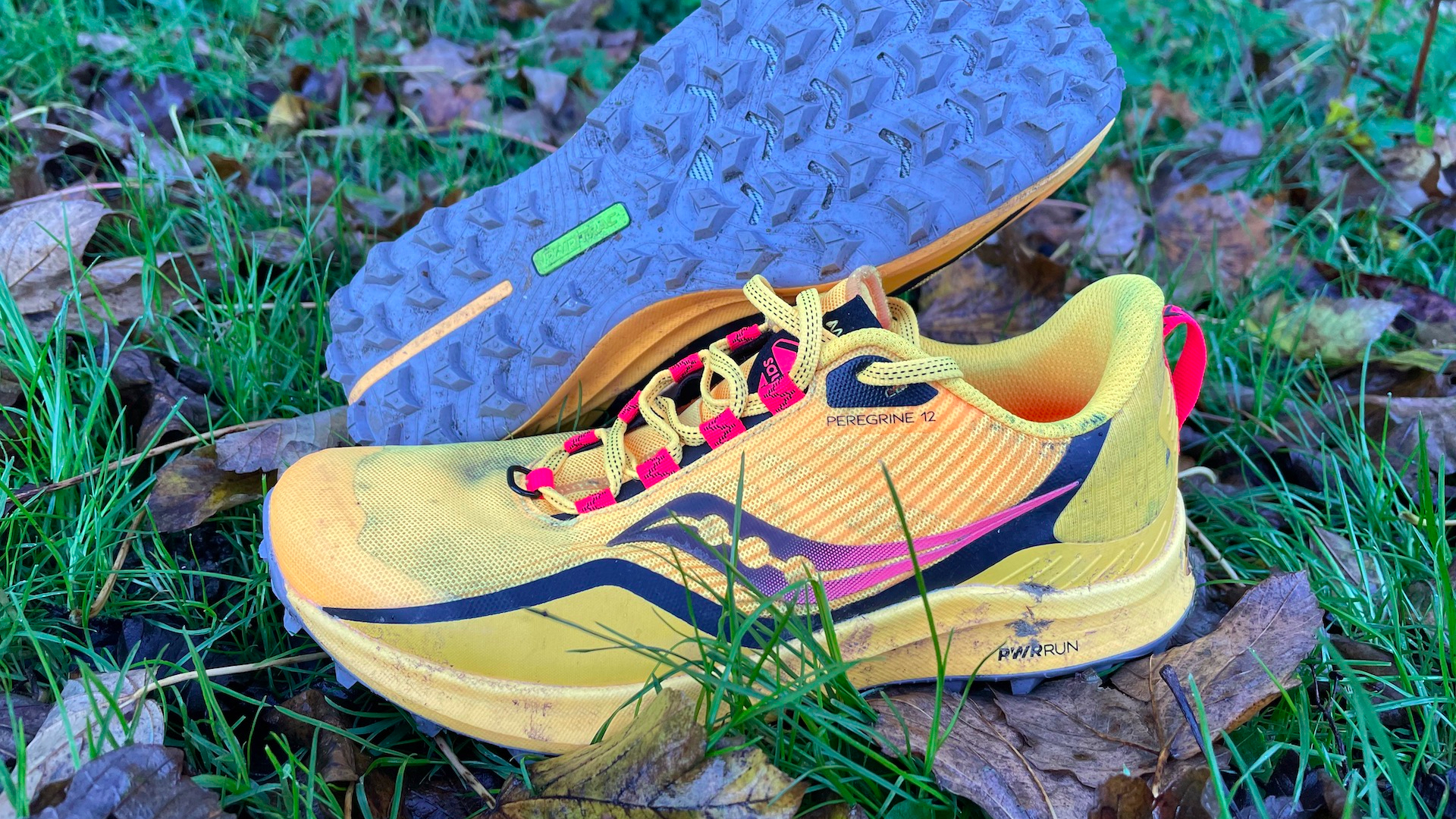
Specifications
Reasons to buy
Reasons to avoid
The hugely popular Peregrine from Saucony is now in its 12th incarnation. It’s one of the lightest trail running shoes currently on the market, weighing in at a featherlight 474g / 16.7oz for a pair of UK size 6.5s. The sizing is spot on, and the fit feels good straight from the box. The heel feels securely cupped, albeit a little on the stiff side. The upper and tongue wrap snugly round the foot and the toe box feels quite roomy.
The good amount of bounce comes from Saucony’s PWR Run cushioning and protection from the rock plate. The ride is springy enough to encourage speed but the Peregrine 12 is not so padded that you can’t feel and respond to the ground below your feet. We found it a good balance between protection, bounce and feeling the terrain.
The grip is great too, especially for winter – 5mm lugs on the PWR Trac outsole provide a nice, tacky grip on all surfaces. They’re most at home on softer, muddier, grassier trails rather than gritty tracks and tarmac roads, and will suit fast mountain races. There is also a D-ring for a debris gaiter and an elastic lace keeper which are nice touches.
Read our full review of the Saucony Peregrine 12.
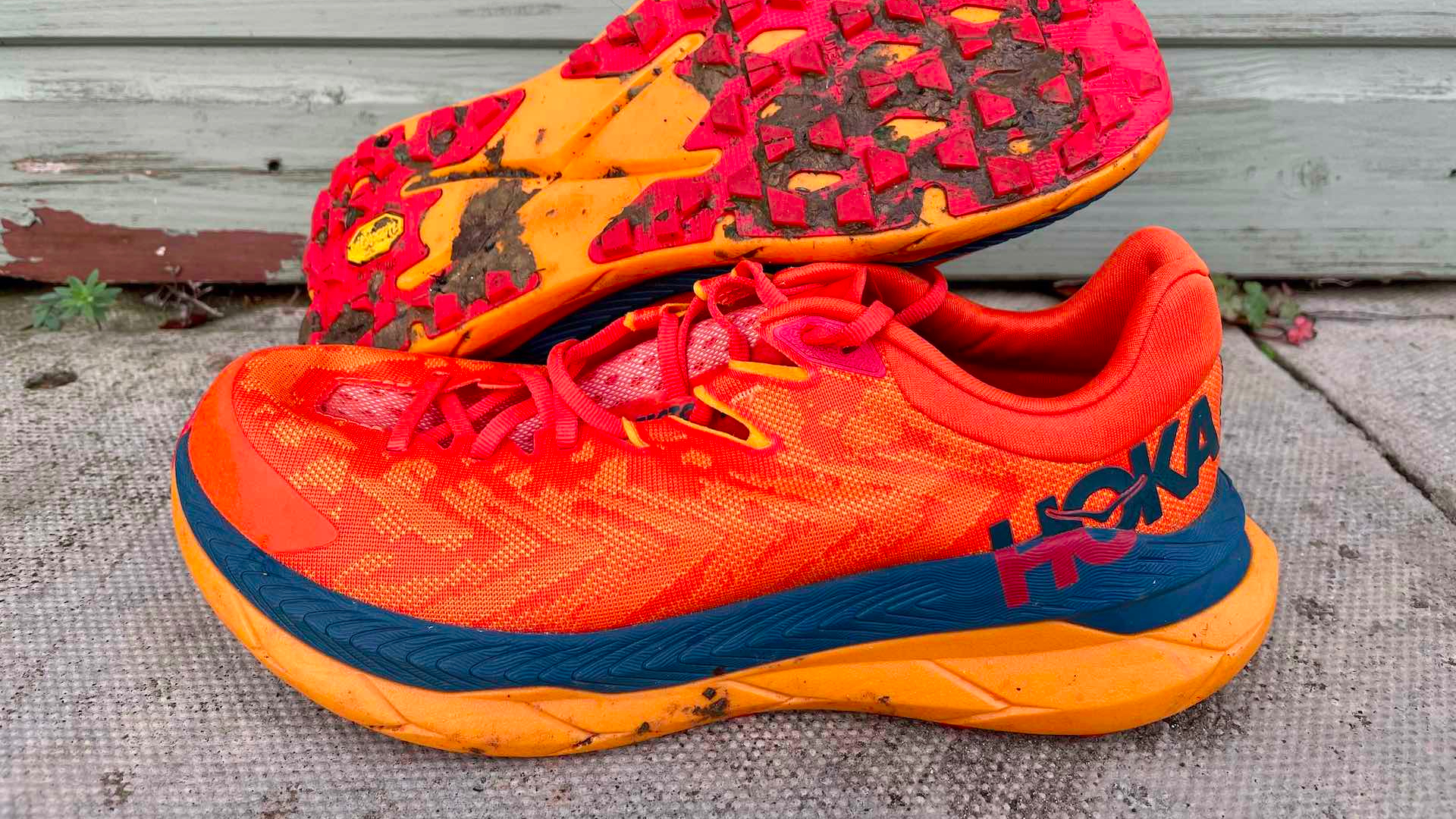
Specifications
Reasons to buy
Reasons to avoid
Carbon fiber plates have come to the trail running world! The Hoka Tecton X has two parallel carbon fiber plates and an early-stage Meta-Rocker to propel you forwards whatever the weather.
The shoe is also really, really light. In a size 8.5 this is lighter than all the rest of the size 6.5 shoes here, apart from the Saucony Peregrine 12, so if you’re looking for a lightweight, propulsive race shoe for mixed terrain this winter, the Tecton X is definitely one to consider.
The cushioning is Hoka’s ProFlyX which provides good comfort and rebound, while the grip is the reliable, durable and light Vibram Megagrip Litebase, which is a great all-rounder for most conditions – although the 4mm lugs are not deep enough for super squelchy mud.
The lacing reaches quite far down the shoe compared to most others here, which allows you to get a really precise fit or keep things more roomy in the midsole area if you have wider or higher volume feet. But it does mean there are more laces to fiddle with and pull to the correct tension. The tongue could also benefit from a little more padding.
The price is very high, but reflects Hoka’s use of this interesting new carbon plate technology.
Read our full review of the Hoka Tecton X.

Specifications
Reasons to buy
Reasons to avoid
The Dynafit Alpine is a versatile and light yet protective trail running shoe that copes well in winter and on mountains paths, but boasts enough padding for a little bit of running on roads and gritty tracks.
The fit is on the small side; we were advised to go up a half size, which fits nicely and feels roomy in the toe box – good for toe splay. The shoe is very comfy straight from the box and the wrap-around tongue gusset is one of the most comfortable we have ever worn.
It would be nice if there was a second lace eyelet at the ankle to really lock down the laces as the heel can move slightly during running. When you get the laces nice and tight you benefit more from what Dynafit call their “Heel Preloader”, a rubbery-feeling TPU band on the outside of the shoe from the inside arch, around the back of the heel to the outside arch. This is designed to propel you forwards rather than relying on the bounce in the midsole.
Traction is great from the 4mm deep lugs in a mud-shedding chevron pattern in the Vibram Megagrip, which works excellently in wet and dry conditions on all surfaces.
Read our full review of the Dynafit Alpine.
The best winter running shoes for icy terrain
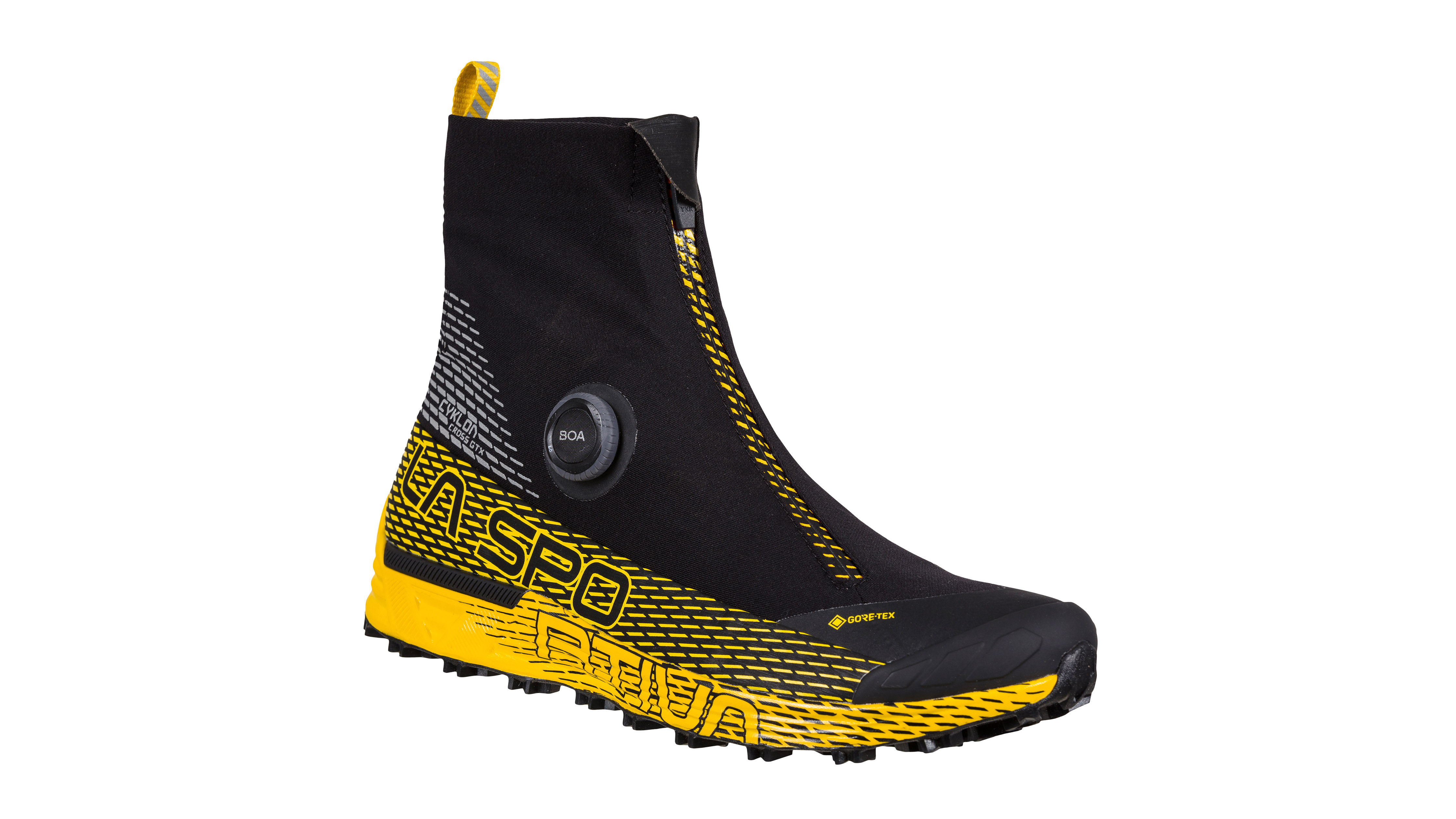
6. La Sportiva Cyklon Cross GTX
Our expert review:
Specifications
Reasons to buy
Reasons to avoid
With a name and a look like something out of science fiction, La Sportiva’s Cyklon Cross GTX is a premium mountain running boot that’s packed with features that will appeal to serious winter runners. They’re the cold season version of La Sportiva’s Cyklon, which we at Advnture were thoroughly impressed with on test last year.
They look heavier than they are, weighing in at just 335g (11.8 oz) per shoe. They feature a 7mm drop and is intended for mid to long distances in the hills and mountains. Once on, they’re really comfortable, fitting like a cycling bootie rather than a standard trail running shoe.
Like their Cyklon brethren, the Cyklon Cross features a BOA fit system, allowing the wearer to fine tune their fit using a dial that tightens the integrated laces. With their stretchy, water-repellent gaiter and their GORE-TEX membrane, stopping water, hail, snow, sleet or any other form of precipitation is clearly high on La Sportiva’s agenda here.
All in all, a very capable trail running shoe that’s most at home on steep, muddy ground. They’re best suited to winter use in the mountains, so won’t appeal to everyone, especially considering their premium price point. Plus, the addition of a zippered gaiter adds a little extra weight compared to the standard Cyklon. However, serious mountain runners will love the unbeatable traction and protection, as well as the gloriously secure BOA fit.
The best winter mixed-terrain running shoes
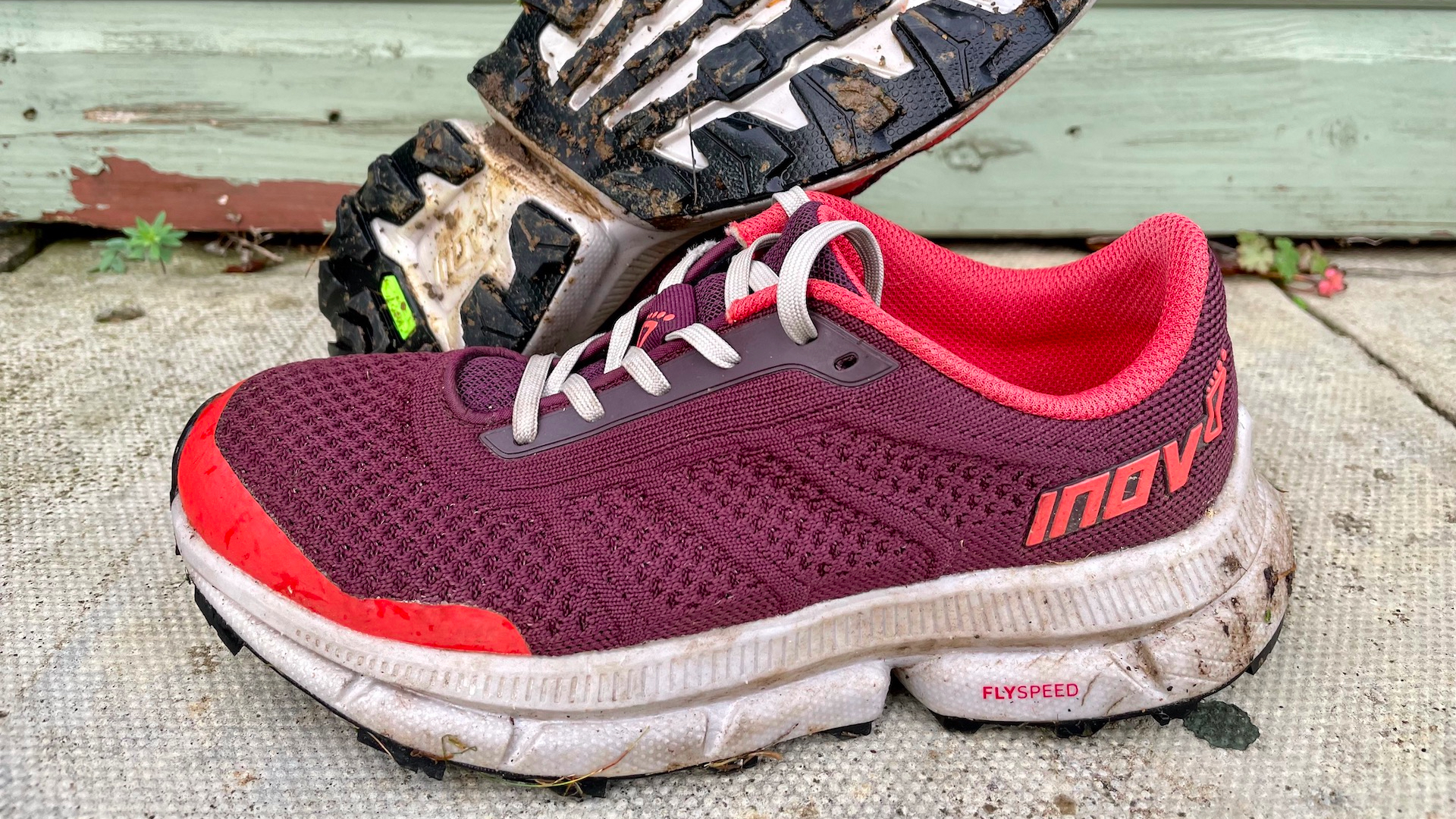
Specifications
Reasons to buy
Reasons to avoid
The exciting feature about the newest running shoe from inov-8 – the TrailFly Ultra G 280 – is the nitrogen-infused Flyspeed midsole foam. It’s designed to give both good rebound and a soft feel (it’s hard to achieve both together) and reduces the use of chemicals. The nitrogen naturally expands in bubbles to give, according to inov-8, “an estimated 50% energy saving during the expansion phase”.
It’s also worth noting that the Flyspeed factory is moving towards 100% sustainable energy, aiming for a future off-grid.
Having run in inov-8 trail (and some road) running shoes since the company started out in 2003, we can reliably say that this is definitely one of the bounciest shoes they’ve made. We would call the others padded and comfy, but they don’t particularly thrust you forwards like these shoes do.
Away from the midsole, the traditional lacing keeps the foot secure in the shoe and the very durable, tough graphene grip works well on wet, slippy pavement slabs and easy trails in winter. But it isn’t designed for deep mud like some of the shoes we are more familiar with from inov-8, such as the Terraultra G-grip 270. Instead, the TrailFly Ultra G 280s are designed for long distances in comfort with a fast feel.

8. Altra Mont Blanc BOA
Our expert review:
Specifications
Reasons to buy
Reasons to avoid
All Altra shoes are wide-fit and zero drop but with the new Mont Blanc BOAs, the US company have worked with BOA lacing systems to create a truly unique trail shoe that uses two dials to lock the shoe firmly into place. One is around the forefoot and the other just under the ankle.
They’re really easy to turn and lock, and you can adjust the tightness over the midfoot part way through your run without re-lacing as you would need to in a traditionally laced shoe.
The outsole is the lightweight Vibram Litebase which is one of the best available on both wet and dry terrain; the grip is not overly aggressive, with lugs 3mm deep, but they’re fairly widely-spaced so mud falls out easily.
The top-end EgoMax padding is enough to feel comfortable on gritty, hard tracks and roads but not on sharp rocks – you can very much feel the trail underfoot. The wide-fit style of the shoe will suit those looking for their toes to splay in a natural way, and the zero drop does take some getting used to (transition slowly to avoid strain and injury to the calf muscles and Achilles tendon). Zero drop does not suit every runner.
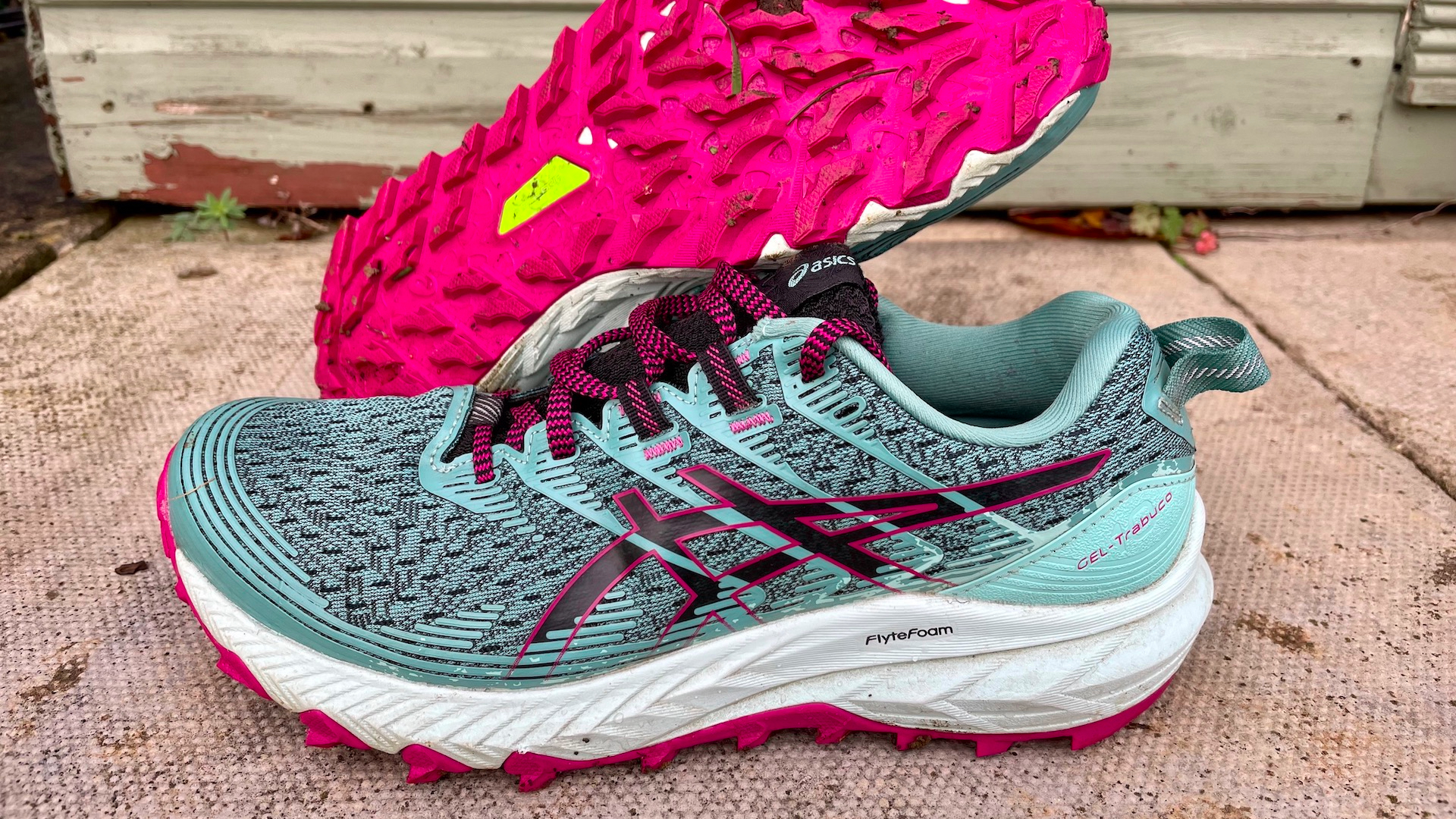
9. Asics GEL-Trabuco 10
Our expert review:
Specifications
Reasons to buy
Reasons to avoid
Asics have used their Duomax support system in the new Asics GEL-Trabuco 10 to create a grippy trail running shoe that helps prevent overpronation, which, to be honest, not many trail runners even think of as a problem, with their feet moving all over the place on uneven ground.
Overpronation is when the foot and ankle roll inwards “too much”. However, pronation is a natural and essential part of the running motion and there is no definite measure of how much is “too much”. Current research points to strengthening weaknesses within the body rather than “correcting” the foot with a stability shoe.
Having said that, the GEL-Trabuco 10 is a very robust, well-made shoe with ample padding for roads yet enough grip (4mm deep lugs from the imaginatively named AsicsGrip) for moderately muddy tracks and trails. It’s comfy and the FlyteFoam midsole gives a good bounce, but it can feel stiff initially if you’re used to a more flexible, less supportive running shoe.
The main thing with running shoes is for them to feel comfy so if you currently get on well with a shoe designed to help with overpronation then this could be an excellent winter trail version for you.
Running shoe | Price | Weight per pair | Drop | Compatibility |
Salomon Speedcross 6 | $140 (US) / £130 (UK) | 527g / 18.6oz (UK 6.5) | 10mm | Muddy trails and mixed terrain, all distances and conditions |
Merrell Agility Peak 4 | $140 (US) / £125 (UK) | 555g / 19.8oz (UK 6.5) | 6mm | Mixed-terrain, any distance, any weather |
Saucony Peregrine 12 | $130 (US) / £130 (UK) | 474g / 16.7oz (UK 6.5) | 4mm | Soft, muddy surfaces, short, fast races, any weather |
Hoka Tecton X | $200 (US) / £175 (UK) | 498g / 17.6oz (UK 8.5) | 5mm | Softer ground, light mud, gritty trails and mountains, all seasons |
Dynafit Alpine | $140 (US) / £145 (UK) | 509g / 18oz (UK 7) | 6mm | Races and short, fast runs in mud and mountains in all weathers |
La Sportiva Cyklon Cross GTX | $235.00 (US) / £190.00 (UK) / €262.90 (EU) | 670 g / 23.6oz (UK 8) | 7mm | winter trail running, mountain running and snowy ground when combined with La Sportiva’s AT Grip spikes (sold separately) |
inov-8 TrailFly Ultra G 280 | $185 (US) / £165 (UK) | 522g / 18.4oz (UK 6.5) | 8mm | Roads, gritty tracks, easy trails, all weathers including rain |
Altra Mont Blanc BOA | $210 (US) / £185 (UK) | 504g / 17.8oz (UK 6.5) | 0mm | Mixed-terrain, roads, trails, ultra distance, all-weather |
Asics GEL-Trabuco 10 | $130 (US) / £125 (UK) | 547g / 19.3oz (UK 6.5) | 8mm | Mixed-terrain, some mud, some road, all distances and conditions |
How we tested the best winter running shoes
All the shoes featured here have been tested by our expert reviewers, who put them through their paces on a mixture of pavements and paths, trails and tarmac, in all sort of winter conditions, from frost to heavy rain and gloopy mud. The performance of each shoe is rated against a list of criteria including comfort, cushioning, grip, fit, foot support, design features, style and the quality of the materials used.
Choosing the best winter running shoes for you

First and foremost, a comfortable fit is your priority when selecting any running shoe. After that, we recommend paying close attention to the following features.
Fit and sizing
You can trust Advnture
In each review we try to give an idea of the size and type of foot and footshape that might best suit that shoe, but it’s still much better if you can get your hands on (or feet into) a few pairs for comparison purposes and try them on before you buy. Remember to use the socks you’d normally run in or the test is pointless.
Grip
In winter you often need either a grippier compound if you’re running on pavements, or deeper lugs if you’re venturing out on muddy trails. The deeper the lugs (for example 5mm) the more traction you’ll get on sloppy ground, wet bogs and deep mud, but the less suited the shoe will be to roads and hard tracks. A nice middle ground is 3mm-4mm lugs if you do a mixture of running on both types of terrain.
Cushioning and rebound
Go for more padding and bounce in the midsole if you mostly run on pavement slabs, cobbles, tarmac and hard-packed gritty tracks. You’ll need less cushioning on softer ground and uneven trails so that your foot can flex and respond quickly and easily to the terrain underfoot, but it’s still nice to have a bit of bounce and a mid-foot rocker to propel you forwards.
Drop / stack
This is the height difference between the heel and toe of the shoe in millimeters. Many more traditional road running shoes have around 10mm heel-to-toe drop so you’re running on a raised heel. If you’re used to this, suddenly changing to a 4mm drop shoe loads your lower leg differently and puts a strain on your Achilles tendons and calf muscles, which can lead to injury.
Find out what drop your current running shoes have and don’t lower the drop by more than a few mm at a time. Rotating new and old shoes – with lower drop shoes worn for a gradually increasing number of miles – is the safest way to do this.
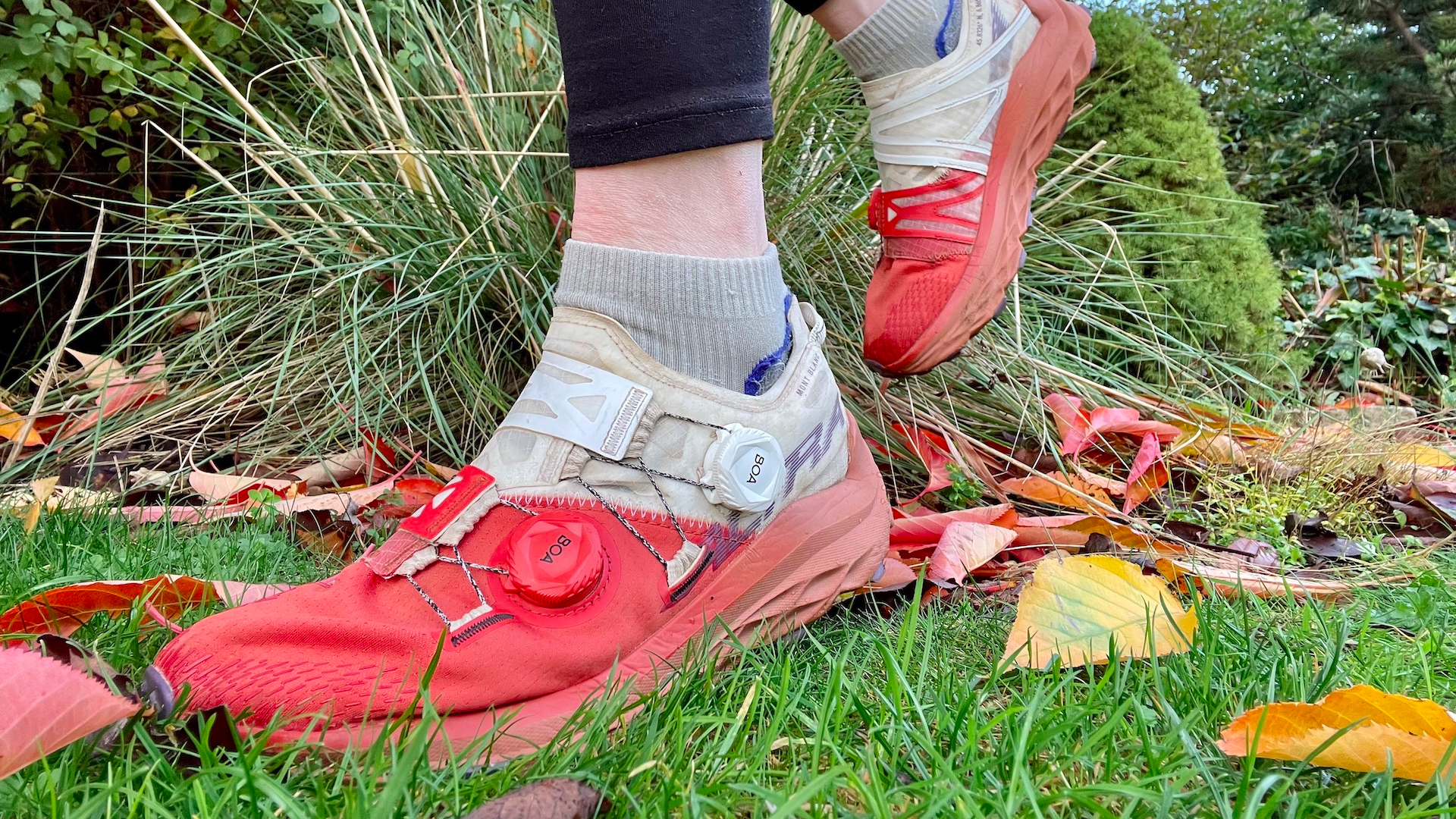
Lacing
In winter you’ll likely have colder, numb hands so it’s worth considering a quick-lace system with a drawcord, or an easy-to-turn dial like in the BOA lacing system. These are by no means essential, however, and they don’t always achieve a snug enough fit for some foot shapes. You can always use fingerless gloves with a mitten over-flap if you’re the type of person who is never quite happy with their lacing and frequently stops to alter it mid-run.
Weight
For winter running you might want a more robust, heavier shoe to cope with the increased muddy load, and for extra warmth, especially if you’re running a long way and / or in remote places. Waterproof shoes (discussed below) are usually heavier because of the extra membrane used.
Breathability
A very breathable upper with wide mesh and / or a lightweight fabric is less welcome in the cold, wet and snow; a more water-resistant material is good for winter. For example, a soft shell fabric like Schoeller can work very well as you still want the uppers to drain excess water when possible.

Waterproofing
You might ask, should I wear waterproof running shoes? Well, a waterproof shoe isn’t always the best choice for winter running, as the rain and splashes from puddles and streams easily get in over the top, and then the juice can’t get out, resulting in trench foot and very heavy, squelchy shoes. They can also make your feet very warm, resulting in the same effect from sweat. So, for most situations it’s best to have a non-waterproof road or trail running shoe so the water can drain out.
Instead, waterproof socks are a good idea for cold or snowy weather, but these aren’t usually as comfortable or well-fitting as your favorite running socks. However, for very cold, windy but mainly dry weather, and / or low, wet vegetation like shorter grass and small puddles, a waterproof shoe can be a wonderful addition to the running gear cupboard.
Eco-friendliness
It’s great to see some brands using more sustainable materials and manufacturing processes to make their running shoes, and we applaud this in our reviews to encourage us all to note this as an important factor in our decision-making. If you’re interested in this topic, read We Can’t Run Away From This by Damian Hall for loads of great ideas on running and living more sustainably.
What to do with your old winter running shoes
Winter running shoes take a beating, and eventually you'll notice leaks and cracks that can't be handled with an application of Shoe Goo. First, check to see whether your local running store accepts used footwear. Many have collection bins and can send it off to be processed by a service like Terracycle, which specializes in items that are hard to recycle via conventional means. Alternatively, if you have a lot of footwear to dispose of, or you can arrange a drive with your running club, you can order a Zero Waste box from Terracycle, which includes a postage label to return it. It's not cheap, but the price would be reasonable if several people chip in.
If you have a Nike store nearby, you can also drop off your old running shoes there. Most stores will accept any brand of athletic shoes in the Reuse a Shoe program, but not boots or ones with metal (so no cleats).
If you're in the UK, Runners Need has in-store collection boxes for used shoes and sportswear, which will be recycled or re-used as part of the Recycle My Run scheme. If they're still in usable condition, you can also send your shoes to Jog On, which is a collaboration between SportsShoes.com and Evri to redistribute used shoes to people in need.
All the latest inspiration, tips and guides to help you plan your next Advnture!
The co-founder and former editor of Trail Running magazine, Claire now runs the YouTube channel Wild Ginger Running, creating films about trail- and ultra-running advice, inspiration, races and gear reviews. An award-winning journalist, writing for outdoor and adventure sports magazines and websites, Claire's first book, The Ultimate Trail Running Handbook (5k to 50k), is out now. Her second, The Ultimate Ultra Running Handbook (50k to 100 miles), is out Autumn 2024. Claire also speaks and presents at events and races.
